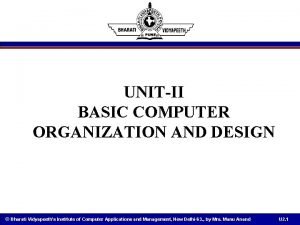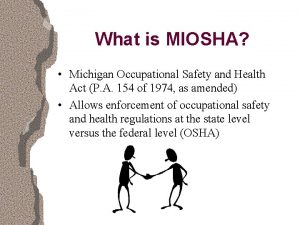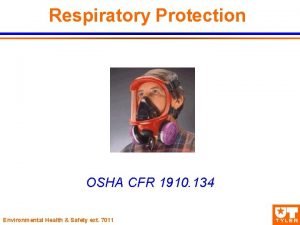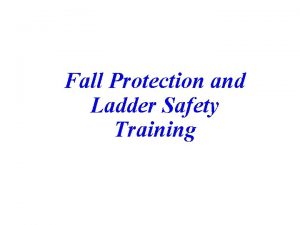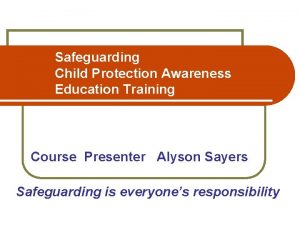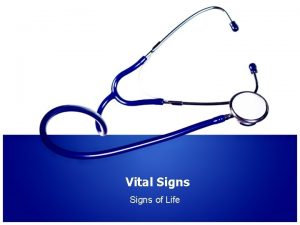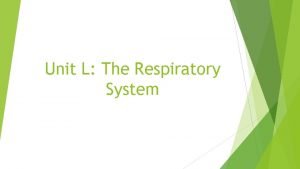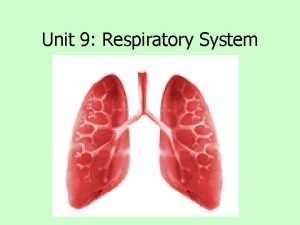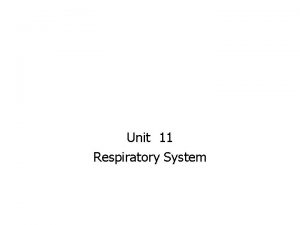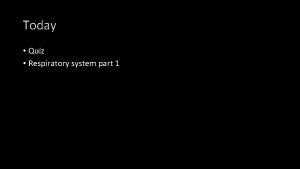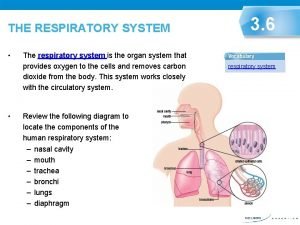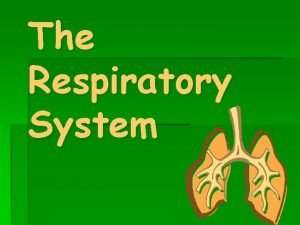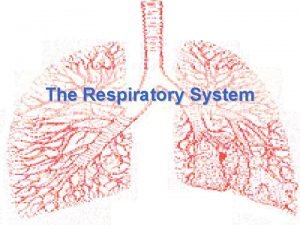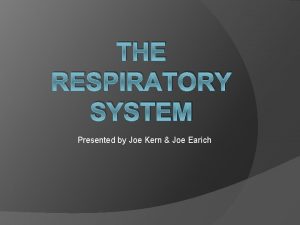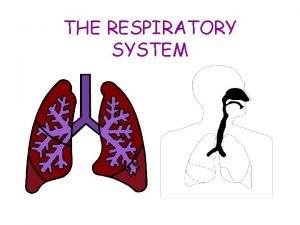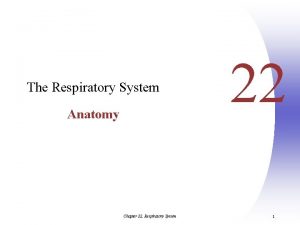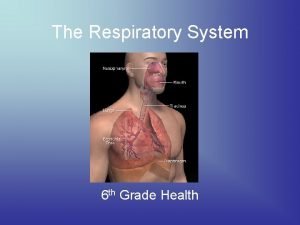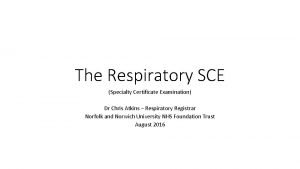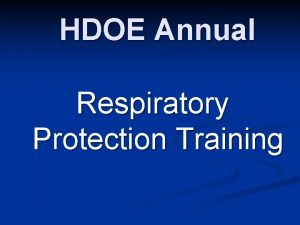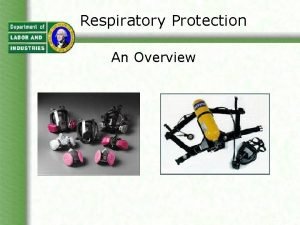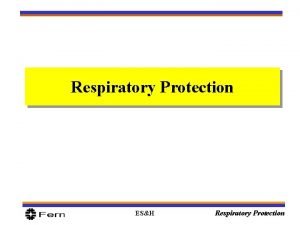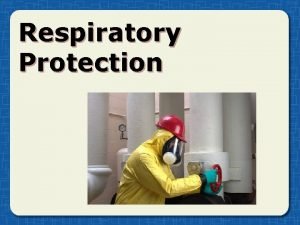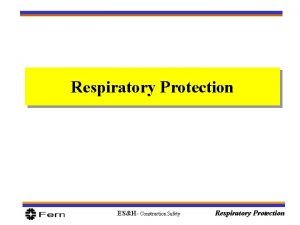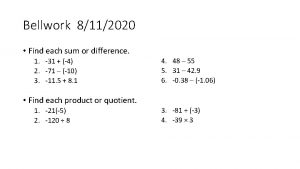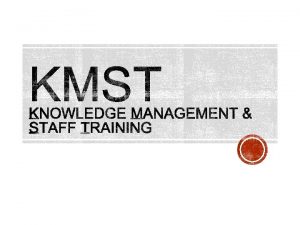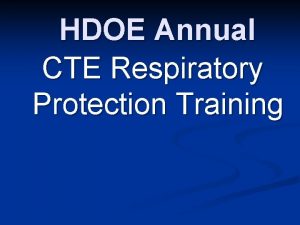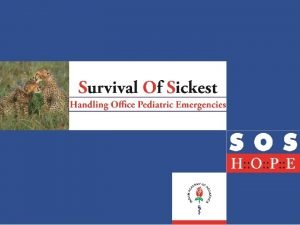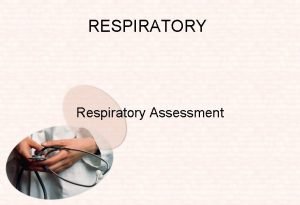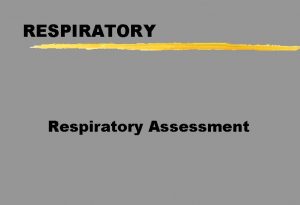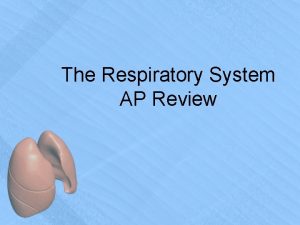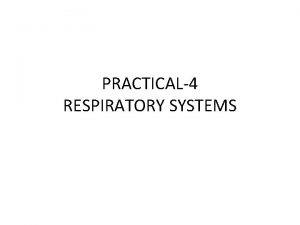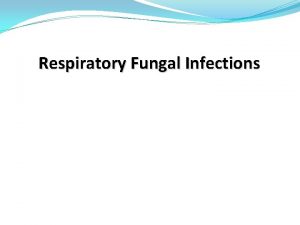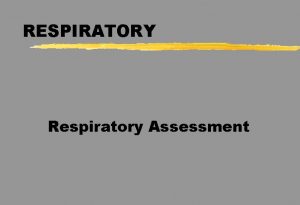N 95 Respiratory Protection Training Updated 8112020 Training


























- Slides: 26

N 95 Respiratory Protection Training Updated 8/11/2020

Training Objectives • Understand the requirements of OSHA 29 CFR Part 1910. 134 • Learn how to set up and administer an OSHA-compliant respiratory protection program • Recognize the differences between masks and respirators • Understand how respirators work - their capabilities & limitations 8/11/2020 2

OSHA 29 CFR Part 1910 (Subpart I) “Personal Protective Equipment” § Employers must assess the workplace to determine if hazards are present, or are likely to be present, which necessitate the use of personal protective equipment (PPE). 1910. 132 General requirements. 1910. 133 Eye and face protection. 1910. 134 Respiratory protection. 1910. 135 Head protection. 1910. 136 Foot protection. 1910. 137 Electrical protective devices. 1910. 138 Hand Protection. + 8/11/2020 3

OSHA 29 CFR Part 1910. 134 “Respiratory Protection Standard” (a) Permissible practice (b) Definitions (c) Respirator program (d) Selection of respirators (e) Medical evaluation (f) Fit testing (g) Use of respirators (h) Maintenance and care (i) Breathing air quality and use (j) Identification of filters, cartridges, and canisters 8/11/2020 (k) Training and information (l) Program evaluation (m) Recordkeeping (n) Dates (o) Appendices (mandatory) A: Fit Testing Procedures B-1: User Seal Checks B-2: Cleaning Procedures C: Medical Questionnaire D: Information for Employees Wearing Respirators When Not Required Under the Standard 4

OSHA Respiratory Protection Program Employer Requirements l Identify & evaluate respiratory hazards in the workplace l Select and provide appropriate respirator based on these respiratory hazards l Designate a program administrator • qualified by appropriate training or experience to administer the respiratory protection program • conducts the required evaluations of program effectiveness l Develop & implement a written respiratory protection program + 8/11/2020 5

8/11/2020 6

Required Elements of the Written Program l Procedures for selecting respirators l Medical evaluations of employees required to use respirators l Fit testing procedures for tight-fitting respirators such as an N 95 l Procedures for proper use of respirators in routine & emergency situations l Procedures and schedules for cleaning, disinfecting, storing, inspecting, repairing, discarding, and maintaining respirators* 8/11/2020 7

Required Elements of the Written Program (cont. ) l Training of employees in respiratory hazards to which they are potentially exposed during routine and emergency situations l Training of employees in proper use of respirators, including donning and doffing, any limitations on their use, and their maintenance l Procedures for regularly evaluating the effectiveness of the program 8/11/2020 8

Medical Aspects of Respirator Use l Must complete medical evaluation prior to initial fit-testing and any use on the job l Must use OSHA questionnaire or medical examination that obtains the same information l Questionnaires and medical examinations are confidential and protected by HIPAA l Not permitted to wear a respirator until medical clearance form signed + 8/11/2020 9

Medical Aspects of Respirator Use (cont. ) l Annual medical evaluations not required l Reevaluation may be needed, if – • • employee reports medical signs or symptoms related to ability to use a respirator supervisor or respirator program administrator reports need for reevaluation observations made during fit testing and program evaluation indicate need for employee reevaluation changes occur in workplace that may result in a substantial increase in physiological burden 8/11/2020 10

OSHA Respiratory Protection Program Training Requirements l No employee will be permitted to work with a respirator until trained in respiratory protection l Must cover the following topics annually: • • • General requirements of appropriate federal & state respiratory protection standards Potential work-related respiratory hazards and risks associated with not using and maintaining respirator properly Function, capabilities, limitations of selected respiratory protection How to inspect, don and remove, check seals, and wear the respirator properly Medical symptoms/signs that might limit/prevent effective use of respirators + 8/11/2020 11

DIRECTIVE NUMBER: CPL-02 -02 -075 EFFECTIVE DATE: 11 -20 -2009 SUBJECT: Enforcement Procedures for High to Very High Occupational Exposure Risk to 2009 H 1 N 1 Influenza 8/11/2020 12

OSHA Can Cite Employers for Failure to: l l l Identify/evaluate respiratory hazards Conduct initial hazard assessment Select/provide appropriate respirators Provide respiratory protection program (w/ fit-testing & medical questionnaire) Implement engineering, work practice and administrative controls Have and implement a program for dealing with a respirator shortage 8/11/2020 13

Facemasks l Loose-fitting - don't provide complete protection l Create physical barrier between mouth and nose of wearer and potential contaminants l Help reduce exposure of wearer’s saliva and respiratory secretions to others l Help block large-particle droplets, splashes, sprays or splatter that may contain viruses and bacteria l Do not filter very small particles transmitted by coughs, sneezes or certain medical procedures 8/11/2020 14

Air-Purifying Respirator (APR) Tight-fitting respirator with a filter, cartridge, or canister that removes specific air contaminants by passing ambient air through the air-purifying element. 8/11/2020 15

Types of Air Purifying Respirators l Particulate Respirators l Gas & Vapor Respirators l Combination Respirators 8/11/2020 16

Examples of Air Purifying Respirators 8/11/2020 17

Particulate, Filtering Facepiece Respirators (Dust Masks) Negative pressure, particulate, air purifying respirator with a filter as an integral part of the facepiece or with the entire facepiece composed of the filtering medium. l N 95 commonly used in healthcare settings as part of airborne precautions l Protects against infectious aerosols 8/11/2020 18

Particulate Filtering Facepiece Classification Resistances N = Not Oil Resistant Efficiencies N 100 N 95 N 99 (95% efficient) (99. 97% efficient or HEPA) R = Oil Resistant R 95 R 99 R 100 P = Oil Proof P 95 P 99 P 100 8/11/2020 19

Particle Filtration Involves 4 Mechanisms: Interception, Inertial Impact, Diffusion, and Electrostatic Charge Mid-size particles captured between respirator fibers. Airstream Fiber Particle Fiber 8/11/2020 20

Particle Filtration Involves 4 Mechanisms: Interception, Inertial Impact, Diffusion, and Electrostatic Charge Large particle inertia causes it to leave airstream and impact respirator fiber. Airstreams Fiber Particle Fiber 8/11/2020 21

Particle Filtration Involves 4 Mechanisms: Interception, Inertial Impact, Diffusion, and Electrostatic Charge Very small particles affected by Brownian motion as opposed to airstream; random motion due to molecular bombardment Airstreams Fiber Particle Fiber 8/11/2020 22

Particle Filtration Involves 4 Mechanisms: Interception, Inertial Impact, Diffusion, and Electrostatic Charge Respirator carries an electrostatic charge which attracts particles. Airstreams Fiber Particle 8/11/2020 23

Why is 0. 3µm Targeted? Increasing Efficiency Overall Efficiency Diffusion Interception Impaction medium & large particles very small particles 0. 1 µm 0. 3 µm 1. 0 µm Particle Diameter (µm) 8/11/2020 larger particles 24 10 µm

N 95 Respirator Rating 95% Filter Efficiency vs Various Particle Size Distributions Higher Efficiency 100 % Efficiency 99 98 Virus (0. 02 - 0. 25 µm) Bacterium (0. 2 - 2 µm) 97 96 95 0. 3 µm 94 0. 01 0. 1 1 10 Particle Size µm (MMAD) 8/11/2020 25

Loose Fitting Powered Air Purifying Respirator (PAPR) • May need PAPR if have facial hair or cannot pass a fit test • No fit testing needed Average Cost > $1, 000 8/11/2020 26
 The symbol tsfa in alu operations include
The symbol tsfa in alu operations include Performance monitoring coaching form
Performance monitoring coaching form Respiratory zone
Respiratory zone What is miosha
What is miosha Osha 1910-134
Osha 1910-134 Scaffold competent person training ppt
Scaffold competent person training ppt Ladder outline
Ladder outline Child protection training materials
Child protection training materials Child protection awareness training
Child protection awareness training Normal respiratory rate
Normal respiratory rate Normal respiratory rate
Normal respiratory rate Respiratory system bozeman
Respiratory system bozeman Unit 9 respiratory system
Unit 9 respiratory system Diagnostic test of respiratory system
Diagnostic test of respiratory system Respiratory zone structures
Respiratory zone structures What is the respiratory system
What is the respiratory system Membranes of larynx
Membranes of larynx Respiratory system coloring page
Respiratory system coloring page Nasal cavity function
Nasal cavity function Respiratory system purpose
Respiratory system purpose Conclusion of the respiratory system
Conclusion of the respiratory system Jobs of the respiratory system
Jobs of the respiratory system Chapter 7 cengage
Chapter 7 cengage Respiratory tree divisions
Respiratory tree divisions Respiratory system
Respiratory system Interesting facts about respiratory system
Interesting facts about respiratory system Acute medicine sce pass mark
Acute medicine sce pass mark
